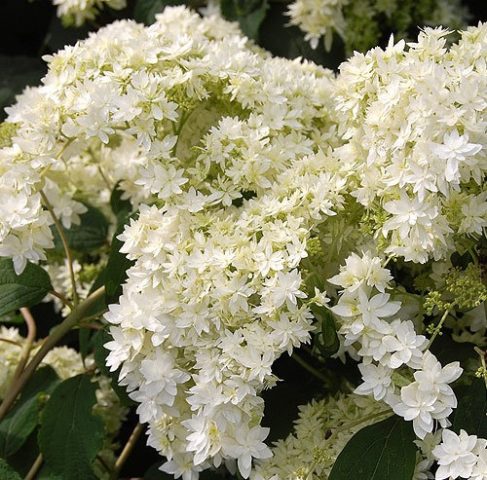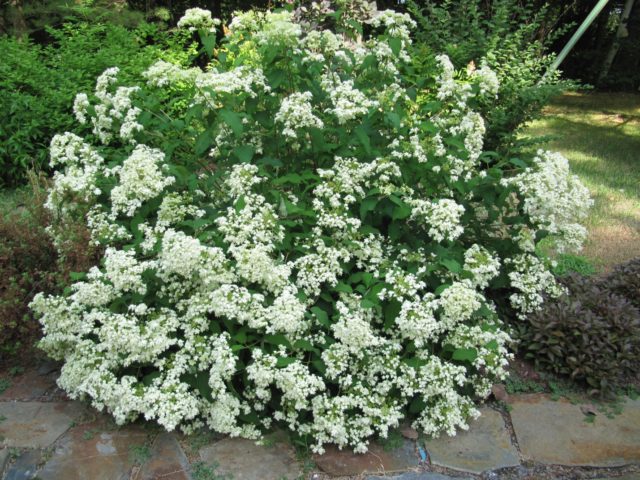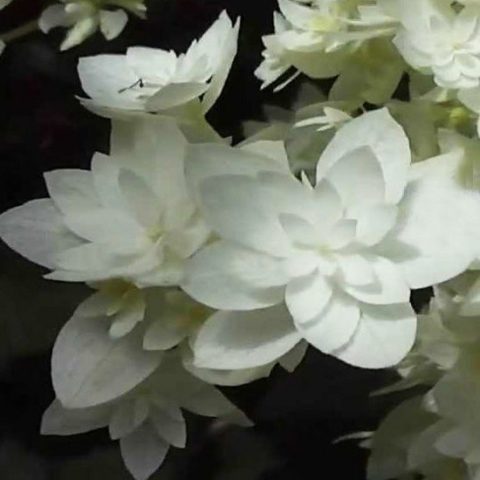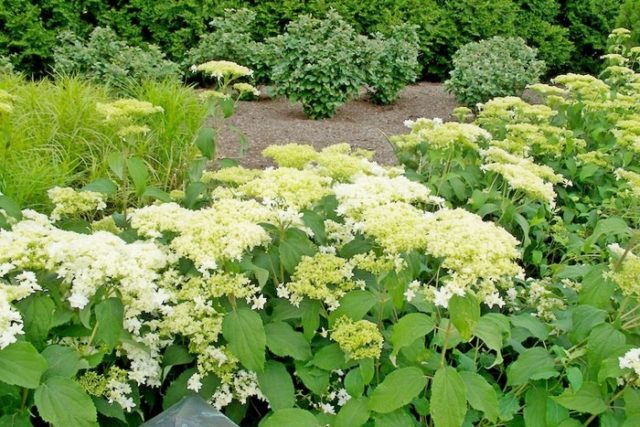Content
Hydrangea Hayes Starburst is an artificially bred tree-like terry variety native to the south of the United States. Sprawling bushes with large dark green leaves from June to autumn frosts adorn the lush umbrellas of small milky-white flowers, shaped like stars. The frost resistance and unpretentiousness of the Hayes Starburst hydrangea allows it to be grown both in conditions with a mild warm climate and in the northern cold regions. This beauty will be a wonderful decoration for any garden, provided that a suitable place on the site is chosen for her and that simple but proper care is provided.
Description of hydrangea tree Hayes Starburst
Hydrangea tree Hayes Starburst bears its name in honor of Hayes Jackson, a gardener from Anniston (Alabama, USA). It is the world's first double-flowered tree hydrangea variety. Its appearance was the result of a "lucky chance" - a natural mutation of the popular variety Annabelle of the Howaria series. The plant was named "Flash of the Star" for its white flowers with sharp petals, when fully expanded, resembling rays scattering in three-dimensional space.

Hayes Starburst is the world's only terry hydrangea variety
The bush of the plant usually reaches 0.9-1.2 m in height, has a rounded-spreading crown with a diameter of about 1.5 m. The shoots are long, thin, graceful, slightly pubescent. They grow rapidly (up to 0.5 m during the season). Stems are straight, but not very strong.
The flowers of hydrangea Hayes Starburst are numerous, small (no more than 3 cm). Most of them are sterile. The petals of the plant are terry with pointed tips. At the beginning of flowering, their color is slightly greenish, then it becomes milky white, retaining a faint shade of green, and by the end of the season it acquires a light pinkish tone.
Flowers are collected in large, asymmetrical umbrellas about 15-25 cm in diameter, located at the ends of the shoots of the current year. Inflorescences in shape can resemble a sphere, hemisphere or truncated pyramid. The plant blooms from late June to October.
The leaves are large (from 6 to 20 cm), oblong, serrated at the edges. There is a heart-shaped notch at the base of the leaf plate. Above, the leaves of the plant are dark green, slightly velvety, from the seamy side - glabrous, bluish in color.
Hayes Starburst hydrangea fruits are formed in September. These are a few small (about 3 mm), ribbed brown boxes. There are small seeds inside.
Hydrangea Hayes Starburst in landscape design
The luxurious beauty Hayes Starburst is characterized by unpretentious care, long flowering duration and high decorative qualities.It looks great both in single plantings on grassy lawns, and in group compositions, where it certainly attracts attention, becoming an exquisite decoration of the territory.
Options for the purpose of hydrangea Hayes Starburst on the site:
- unformed hedge;
- placement along structures or fences;
- separation of zones in the garden;
- background plant in mixborder or discount;
- "Disguise" for an indescribable corner of the garden;
- combination with coniferous shrubs and trees;
- design of front gardens, recreation areas;
- landscape compositions with perennial flowers, plants of the lily family, as well as phlox, geranium, astilba, barberry.

Hydrangea Hayes Starburst looks great both in compositions with other plants, and in a single planting
Winter hardiness of hydrangea terry Hayes Starburst
Hydrangeas Hayes Starburst is characterized by high winter hardiness. In the presence of a dry shelter, this variety is able to withstand frosts of the middle climatic zone and a drop in temperature down to -35 ° C.
Planting and caring for hydrangea Hayes Starburst
The Hayes Starburst hydrangea variety is considered unpretentious. However, the health of the plant, and, therefore, the duration and abundance of its flowering depends on how correctly the place for planting the bush is determined and what measures are taken to care for it.
A brief overview of the characteristics of the hydrangea variety Hayes Staburst and the preferred conditions in the garden for this plant in the video https://youtu.be/6APljaXz4uc
Selection and preparation of the landing site
The site where it is supposed to plant Hayes Starburst hydrangea must have the following characteristics:
- semi-shabby throughout the day, but at the same time it is well illuminated by the sun in the morning and evening;
- protected from gusts of wind and drafts;
- the soil is light, fertile, humus, slightly acidic, well-drained.
Hydrangea Hayes Starburst is photophilous, but it can also grow in shaded areas. However, in case of excess bright sunlight, the flowering period of this plant will be shortened by about 3-5 weeks. If the bush is constantly in the shade, then the number and size of its flowers will be less than under optimal conditions.
Ideal for hydrangea Hayes Starburst - planting in the north, north-east or east of the garden. It is desirable that there is a fence, building wall or trees nearby.

A correctly chosen planting site is the key to a lush and long-lasting hydrangea bloom
Landing rules
The time for planting hydrangea Hayes Starburst in an open area depends on the climatic region:
- in the north, this is done in early spring, as soon as the ground thaws enough;
- in southern, warmer conditions, seedlings can be rooted in the ground either in the spring, before the buds swell, or in the fall, immediately after the leaves fall.
It is optimal to choose young 3-4-year-old plants with a closed root system for planting.
Immediately before planting, the Hayes Starburst seedlings should be removed from the containers, the roots should be cut by 20-25 cm, and damaged and dry shoots should be removed.
The technology for planting a tree hydrangea in the ground is as follows:
- it is necessary to prepare a landing pit approximately 30 * 30 * 30 cm in size;
- pour a nutritious mixture of 2 parts of black soil, 2 parts of humus, 1 part of sand and 1 part of peat into it, as well as mineral fertilizer (50 g of superphosphate, 30 g of potassium sulfate);
- install a plant seedling in the hole, spread its roots, making sure that the root collar remains at the level of the soil;
- cover with earth and gently tamp it;
- water the plant abundantly at the root;
- mulch the near-trunk circle with sawdust, peat, needles.
Watering and feeding
The root system of Hayes Starburst hydrangea is shallow and branched. This plant is very moisture-loving and needs regular watering. Drying out of the soil under it must not be allowed.
The frequency of watering is approximately as follows:
- in a dry, hot summer period - 1-2 times a week;
- if it rains, it will be enough once a month.
One-time water rate for one bush of Hayes Starburst hydrangea is 15-20 liters.
Simultaneously with watering, the soil should be loosened in the near-stem circles of the plant to a depth of 5-6 cm (2-3 times during the season), as well as weeds should be weeded.

Small double flowers of hydrangea Hayes Starburst in shape resemble stars
Hayes Starburst hydrangeas work well with almost any dressing, but in moderation. Fertilize it according to this principle:
- the first 2 years after planting in the ground, it is not necessary to feed a young plant;
- starting from the third year, in early spring, urea or superphosphate, nitrogen, potassium sulfate should be added under the bushes (you can use a ready-made fertilizer mixture enriched with trace elements);
- at the stage of bud formation, add nitroammophos;
- during the summer, every month you can enrich the soil under the plants with organic matter (infusion of chicken droppings, rotted manure, grass);
- in August, fertilization with nitrogen substances should be stopped, limiting ourselves to compositions based on phosphorus and potassium;
- to strengthen the shoots during this period, it is necessary to spray the leaves of the plant with a weak solution of potassium permanganate.
It is also important to know that you cannot feed this plant with lime, chalk, fresh manure, ash. These fertilizers greatly reduce the acidity of the soil, which is unacceptable for hydrangeas.
Pruning hydrangea tree-like terry Hayes Starburst
The first 4 years, you do not need to prune the Hayes Starburst hydrangea bush.
Further, regular pruning of the plant is performed 2 times a year:
- In the spring, before sap flow begins, diseased, broken, weak branches, shoots frozen in winter are removed. At the budding stage, the weakest branches with inflorescences are cut off so that the remaining inflorescences are larger.
- In the fall, before the onset of winter, they thin out the dense growth, remove the umbrellas that have faded. Also during this period, the shoots that have grown over the year are reduced by 3-5 buds.
In addition, every 5-7 years, it is advised to carry out sanitary pruning of the plant, cutting off the processes by about 10 cm.
Preparing for winter
In the northern regions, before the onset of winter, the Hayes Starburst hydrangea bushes mulch with dry foliage and spud the earth. In a southern climate, this procedure is carried out during the first 2 years after planting in open ground. It is also allowed to cover plants for the winter with coniferous spruce branches or to insulate them with a covering material.

So that the branches of the Hayes Starburst hydrangea do not break under the weight of the adhered snow, they are tied together, after carefully bending them to the ground
Reproduction
Most often, the Hayes Starburst tree hydrangea is propagated using green cuttings, which are cut from the young side shoots of the current year's plant. They are harvested in the summer, after the buds appear on the bush, in this way:
- Cut shoots are immediately placed in water and placed in a dark place.
- Then the upper part with the bud and the lower leaves are removed from the branch. The rest of the shoot is divided into several parts of 10-15 cm, each of which should have 2-3 nodes with buds.
- The lower part of the cutting is cut under the first knot, maintaining an angle of 45 °.
- The leaves should also be cut in half using scissors.
- Then the cuttings are placed for 2-3 hours in a special solution ("Kornevin", "Epin"), which stimulates plant growth and root formation.
- After that, they are placed in containers filled with water mixed with cinnamon powder (1 tsp per 200 ml) and wait until the roots appear.
- When the roots reach a length of 2-5 cm, the plants are planted in pots with moist soil from a mixture of garden soil, peat and sand. You can cover the cuttings with glass jars or cut plastic bottles for quick rooting (from time to time, such a shelter should be opened for ventilation).
- Pots with cuttings are kept in a shaded place. Water the seedlings 2-3 times a week.
- With the arrival of the next spring, the hydrangea is planted in the open air, having previously hardened the plants on the loggia or veranda.
Briefly and clearly, the propagation process of Hayes Starburst hydrangea by cuttings is presented in the photo:

The most popular way to propagate tree hydrangeas is from green cuttings.
Other methods of propagation of hydrangeas are also practiced:
- winter cuttings;
- dividing the bush;
- rooting of cuttings;
- branch of overgrowth (offspring);
- germination of seeds;
- graft.
Diseases and pests
The main diseases and pests that can harm the Hayes Starburst hydrangea are as follows:
Disease / pest name | Signs of defeat | Prevention and control measures |
Powdery mildew | Pale yellow-green spots on the leaves of the plant. On the reverse side there is a gray powdery coating. Rapid fall of green mass | Removal and destruction of affected parts. Fitosporin-B, Topaz. |
Downy mildew (downy mildew) | Oily spots on foliage and stems that darken over time | Removal of affected areas. Bordeaux mixture, Optimo, Cuproxat |
Chlorosis | Large yellow spots on the leaves, while the veins remain green. Fast drying of foliage | Softening the acidity of the soil. Fertilizing hydrangeas with iron |
Leaf aphid | Colonies of small black insects visible on the back of the leaves. The green mass of the bush dries up, turns yellow | Soap solution, tobacco dust decoction. Spark, Akarin, Bison |
Spider mite | The leaves are curled, covered with small reddish spots. Thin cobwebs are visible on their seamy side. | Soap solution, mineral oil. Akarin, Lightning |

Healthy hydrangea Hayes Starburst pleases with flowers all summer until autumn frosts
Conclusion
Terry tree hydrangea Hayes Starburst, which blooms magnificently all summer and part of autumn, will perfectly decorate a flower bed, a garden plot or a recreation area in a park. Making a choice in favor of this variety will push a long and very beautiful flowering, undemanding care and excellent winter hardiness of the plant. However, when planting a Hayes Starburst bush in your garden, you need to correctly determine the place where hydrangeas are to grow, if necessary, tie up flowering shoots, and also provide it with regular abundant watering, proper pruning and feeding. In this case, the plant will show the strongest qualities inherent in the variety, and will allow you to admire the abundance of beautiful white flowers against the background of bright green foliage for a long time.








